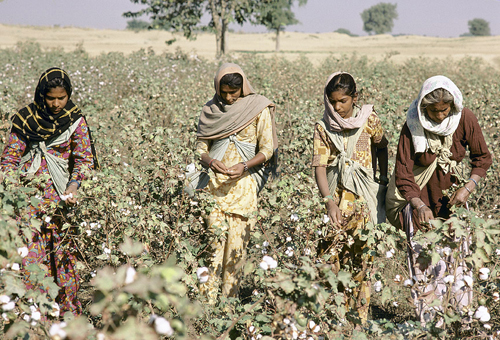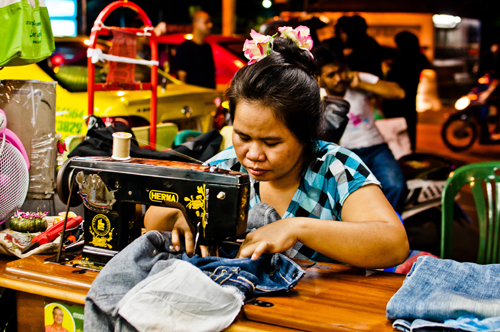
DAVID ADAMS reports on the release of Australian Baptist World Aid’s 2017 Ethical Fashion Report…
Gershon Nimbalker, advocacy manager at Baptist World Aid Australia, is upbeat about the changes that have taken place in the fashion industry – both in Australia and overseas – since the launch four years ago of the organisation’s first examination of how fashion brands are – or aren’t – protecting supply chain workers from exploitation.
“We’ve seen some really significant improvements in a bunch of critical areas,” he says. “More than ever now, companies are tracing deeper into their supply chains.”


SUPPLY CHAIN WORKERS: Cotton pickers in India and a garment maker in Thailand are among those involved in Asia’s massive garment-making industry which the Ethical Fashion Report is seeking to ensure are protected from exploitation. PICTURES: Courtesy of Baptist World Aid Australia.
“We’ve seen some really significant improvements in a bunch of critical areas. More than ever now companies are tracing deeper into their supply chains.”
– Gershon Nimbalker, advocacy manager at Baptist World Aid Australia.
Speaking as the latest Ethical Fashion Report was released this week, Mr Nimbalker that in the last year alone, half of the 106 companies – representing some 330 brands – included in the latest report improved the strength of labour rights management systems.
The fourth produced since 2013 (and released for the first time in New Zealand as well as Australia through partner agency Tearfund New Zealand), the 2017 report also shows that 81 per cent of companies were trying to trace the source of fabrics and 45 per cent are attempting to trace where cotton is sourced from – encouraging signs, says Mr Nimbalker, given that “it’s in those areas where the worst forms of labour rights abuses, like slavery and child labour, are at their most extreme”.
Among other positive findings in the latest report include a rise in the number of companies publishing full supplier lists – initially rejected by some companies as compromising commercially protected information – from 16 per cent to 26 per cent in the past year alone. Overall, 59 per cent of those companies which were assessed in the 2016 report improved their grade in the 2017 report.
Despite that, Mr Nimbalker says the latest report – which, like the previous reports, grades companies from A to F based on the strength of the systems they have in place to mitigate the risks of exploitation in their supply chain, shows that there is still much work to be done.
Of the companies featured in the report only 15 were awarded a grade in the A range (C+ was the median grade and 10 companies received a grade of F), while only seven per cent of companies know where all their cotton comes from and just one, Mighty Good Undies, could prove they were paying all their workers a living wage.
Mr Nimbalker says the latter – ensuring all workers in the supply chain were paid a “living wage”, defined as a wage that covers the basic costs needed to survive as well as a little extra to cover a worker and their family in a time of distress – remained one of the biggest challenges in the industry.
“Living wages are consistently the thing that workers are most concerned about in the fashion supply chain,” he says. He adds that while more companies are now investing in improving local wages – rising from 11 per cent in the 2013 report to 42 per cent in this year’s, “it’s also an area where not enough progress is being made”.
Mr Nimbalker says that if the issue of a living wage is addressed, “most of the other levels of worker abuse and exploitation will drop off really significantly”. “It’s usually the biggest, most demonstrable benchmark that the rights of workers are being listened to and responded to,” he notes. “Where workers are being paid a living wage, in most instances they’re empowered, they talk about abuses that occur around them, and it changes the shape of what their working conditions are like”.
The report also shows that Australian companies are lagging behind multi-nationals when it comes to ensuring workers in their supply chains are protected. Of 15 brands which received an A grade or higher, only three Australian-headquartered companies – Fairtrade businesses Etiko, Mighty Good Undies and RREPP – were ranked alongside multi-nationals like Zara, Pull&Bear and Patagonia.
But Mr Nimbalker is quick to add that there are a number of well-known Australian brands – including Cotton On, Supre, Jag, Sportscraft, and Bonds – which were “nipping at their heels”.
The care of fashion industry workers is something of a local issue for Australia with the neighbouring Asia Pacific region home to more than 40 million fashion industry workers – China being the biggest producer, followed by India. Sadly, the region is also estimated to be home to more than half of all the world’s forced labourers – more than 11.7 million people – as well as some 78 million child labourers.
“The fashion industry, being highly labour intensive and at various points quite low skilled means that many of the most vulnerable workers are working to produce garments,” says Mr Nimbalker. “So it’s a very high risk area and it just re-emphasises the importance that companies need to implement systems to mitigate those risks.”
While the report is focused on how companies are addressing issues involving in ensuring workers aren’t exploited, Mr Nimbalker notes that a number of governments in the region – including those of Vietnam, Thailand, Cambodia and Bangladesh – have also been taking some welcome steps forward in tackling the issue.
Governments in Western nations like Australia, where the end products are sold, meanwhile, also have an important role to play and Mr Nimbalker says law-makers in countries including the US, France, Denmark, and the UK have already introduced legislation aimed at protecting supply chain workers. “And the Australian Government is now actively considering whether we should have this legislation here as well.”
“Use the social media feed, write a letter, engage with the company. Advocacy has far more impact on the company than just a boycott which they may not even know about.”
– Gershon Nimbalker.
In a bid to apply pressure to the industry, Baptist World Aid Australia are asking consumers to preference those companies which are performing well in terms of ensuring supply chain workers are protected. To aid consumers in identifying those that are it has produced a hardcopy guide to the rankings which can be carried while shopping (free to order via the website) and, for the first time, has also this year produced an online tool, the Ethical Fashion Fast Finder, which can be used on a mobile phone.
But Mr Nimbalker, who notes that an increasing number of companies contacted in compiling the report have engaged with the process (up to 83 per cent from just 49 per cent in 2013), says they’re also asking people to go a step further and get in touch with their favorite brand and call on them to do better if they’re not doing enough.
“Use the social media feed, write a letter, engage with the company. Advocacy has far more impact on the company than just a boycott, which they may not even know about.”
Mr Nimbalker says that while protecting supply chain workers from exploitation may mean people in countries like Australia have to pay more for the end products, the labour costs represent such a small proportion of a garment’s cost that it will likely only add a small percentage to final price.
“So to see that workers in Bangladesh get a living wage, for instance, there’s been some estimates that suggest it could be as little as an additional 40 cents per T-shirt.,” he says. “So, yes, there has to be a change in expectation – we can’t keep expecting clothes to get cheaper and cheaper – but the change is certainly something that consumers and companies should be able to afford…
“Given that so many people are living below the poverty line and the relative wealth that we experience in many developed countries, I think it’s inexcusable that we don’t make that shift to ensure that workers get to live life with dignity.”





